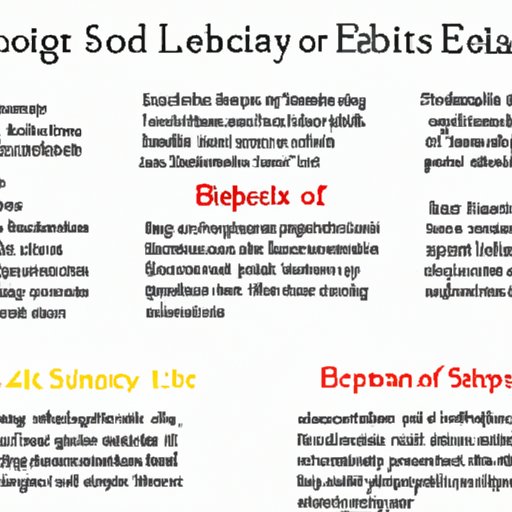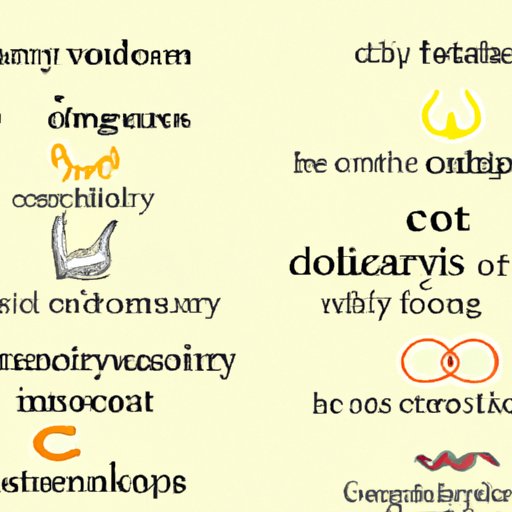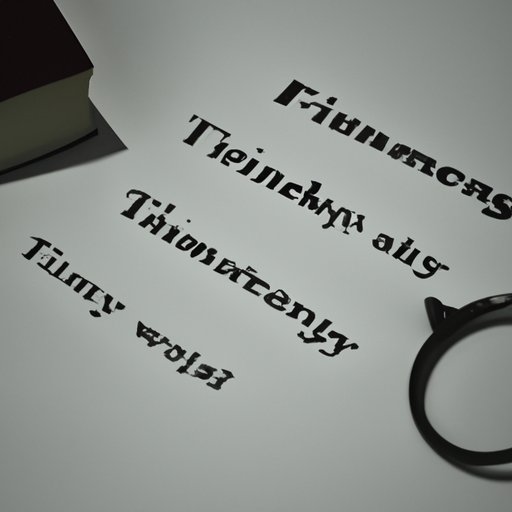Introduction
In literature, symbols are used to represent ideas, thoughts, and emotions. They can be found in both fiction and nonfiction works and are often used to create moods and atmospheres while also expressing abstract concepts. Symbols can also be used to enhance character development and deepen the overall meaning of a story. In this article, we will explore the role of symbolism in literature, examining types of symbols, their uses, and examples of symbols found in popular works.

Exploring the Use of Symbols in Literature: An Overview
A symbol is an object, person, or concept that stands for something else. It is a representation of an idea, thought, or emotion that has more than one meaning. Symbols can be found in literature, art, music, and other forms of media. In literature, symbols are used to convey meaning and evoke emotion. They can be used to create moods and atmospheres, express abstract ideas, and enhance character development.
There are many different types of symbols that can be used in literature. Common symbols include nature symbols, color symbols, animal symbols, and religious symbols. Each type of symbol has its own set of meanings and associations. By understanding these meanings, authors can use symbols to communicate messages to their readers.

Examining Common Symbols in Literature and Their Meanings
Nature symbols are some of the most commonly used symbols in literature. Nature symbols can represent life, death, growth, and renewal. For example, the sun has often been used to symbolize new beginnings, fresh starts, and hope. Similarly, rain can be used to symbolize cleansing and renewal.
Color symbols are also often used in literature. Colors can evoke certain emotions and feelings, making them ideal for conveying messages to readers. For example, red is often used to symbolize passion, love, and danger. Blue, on the other hand, can be used to represent peace, tranquility, and serenity.
Animal symbols are also commonly used in literature. Animals can represent various qualities, such as strength, intelligence, courage, and loyalty. For example, the lion is often used to symbolize power and leadership, while the dove is used to symbolize peace and kindness.
Religious symbols are also used in literature. These symbols can be used to represent spiritual beliefs or values. For example, the cross is often used to represent Christianity and its teachings. Other religious symbols, such as the Star of David or the crescent moon, can be used to represent Judaism and Islam, respectively.
The Role of Symbolism in Literary Works
Symbols play an important role in literary works. They can be used to create moods and atmospheres, express abstract ideas, and enhance character development. Symbols can also be used to add depth and meaning to stories, making them more interesting and engaging for readers.
Symbols can be used to create moods and atmospheres in a story. For example, the use of darkness and shadows can create a feeling of dread and foreboding. Similarly, bright colors and light can be used to create a sense of joy and optimism. By using symbols, authors can create vivid mental images that evoke certain emotions in readers.
Symbols can also be used to express abstract ideas. For example, a white dove may be used to represent peace, while a red rose may be used to represent love. By using symbols, authors can communicate complex concepts without having to use long descriptions or explanations.
Finally, symbols can be used to enhance character development. By using symbols to represent characters’ traits or inner conflicts, authors can make characters more relatable and believable. For example, a character who is struggling with addiction may be represented by a broken bottle, while a character who is struggling with depression may be represented by a dark cloud.
Analyzing Symbolism in Poetry and Prose
Symbols can be used in both poetry and prose. In poetry, symbols can be used to create vivid imagery and evoke strong emotions. For example, the use of colors can be used to create a specific atmosphere or mood. In addition, symbols can be used to emphasize certain words or phrases, adding emphasis and meaning to the poem.
In prose, symbols can be used to create characters, settings, and plot points. For example, a character’s clothing can be used to symbolize their personality or inner conflicts. In addition, symbols can be used to add depth and complexity to a story, making it more interesting and engaging for readers.
Understanding Symbolism in Fiction and Nonfiction Writing
Symbols can be used in both fiction and nonfiction writing. In fiction writing, symbols can be used to create vivid imagery and evoke strong emotions. For example, the use of colors can be used to create a specific atmosphere or mood. In addition, symbols can be used to emphasize certain words or phrases, adding emphasis and meaning to the story.
In nonfiction writing, symbols can be used to convey abstract concepts or ideas. For example, the use of metaphors can be used to explain complex concepts in a simple and understandable way. In addition, symbols can be used to illustrate points or arguments, making them easier to understand.

Investigating Iconic Symbols in Literature
Symbols can be found in many iconic works of literature. For example, in William Shakespeare’s Romeo and Juliet, the balcony scene is often seen as a symbol of forbidden love. In Harper Lee’s To Kill a Mockingbird, the mockingbird is used to symbolize innocence and justice. In J.K. Rowling’s Harry Potter series, the Deathly Hallows symbolizes death and immortality.
Recognizing and understanding these symbols can help readers gain a deeper understanding of the stories. By understanding the symbolic representations in popular works, readers can gain insight into the characters, themes, and messages of the stories.
Conclusion
Symbols are a powerful tool used by authors to convey meaning and evoke emotion in their writing. In this article, we explored the role of symbolism in literature, examining common symbols, their meanings, and how they are used in poetry and prose. We also discussed how symbols can be used to create moods and atmospheres, express abstract ideas, and enhance character development. Finally, we investigated iconic symbols in literature and examined their impact on the overall story.
Symbols are an important part of literature and can be used to create powerful stories that resonate with readers. By understanding the role of symbols in literature, readers can gain a deeper understanding of the stories they read.
(Note: Is this article not meeting your expectations? Do you have knowledge or insights to share? Unlock new opportunities and expand your reach by joining our authors team. Click Registration to join us and share your expertise with our readers.)
